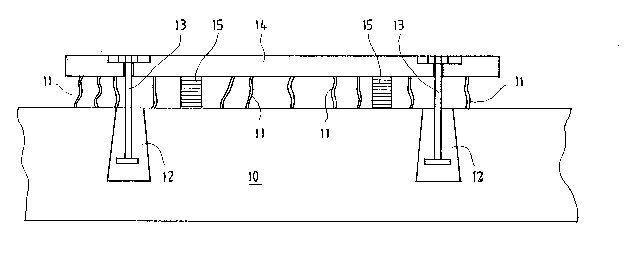Une partie des informations de ce site Web a été fournie par des sources externes. Le gouvernement du Canada n'assume aucune responsabilité concernant la précision, l'actualité ou la fiabilité des informations fournies par les sources externes. Les utilisateurs qui désirent employer cette information devraient consulter directement la source des informations. Le contenu fourni par les sources externes n'est pas assujetti aux exigences sur les langues officielles, la protection des renseignements personnels et l'accessibilité.
L'apparition de différences dans le texte et l'image des Revendications et de l'Abrégé dépend du moment auquel le document est publié. Les textes des Revendications et de l'Abrégé sont affichés :
| (12) Brevet: | (11) CA 2043824 |
|---|---|
| (54) Titre français: | METHODE DE REALISATION DES DALLES DE FONDATION POUR UNE MACHINE A PAPIER AVANT L'INSTALLATION DE LADITE MACHINE |
| (54) Titre anglais: | METHOD FOR MAKING THE FOUNDATION SLABS OF A PAPER MACHINE BEFORE THE INSTALLATION PROPER OF THE MACHINE |
| Statut: | Périmé et au-delà du délai pour l’annulation |
| (51) Classification internationale des brevets (CIB): |
|
|---|---|
| (72) Inventeurs : |
|
| (73) Titulaires : |
|
| (71) Demandeurs : |
|
| (74) Agent: | MARKS & CLERK |
| (74) Co-agent: | |
| (45) Délivré: | 1996-01-09 |
| (22) Date de dépôt: | 1991-06-04 |
| (41) Mise à la disponibilité du public: | 1991-12-08 |
| Requête d'examen: | 1993-04-23 |
| Licence disponible: | S.O. |
| Cédé au domaine public: | S.O. |
| (25) Langue des documents déposés: | Anglais |
| Traité de coopération en matière de brevets (PCT): | Non |
|---|
| (30) Données de priorité de la demande: | ||||||
|---|---|---|---|---|---|---|
|
The invention concerns a method for making the foundation
slabs of a paper machine. In the method, reinforcement strands are
fitted inside a mold for a base beam. Before filling-concreting of
the mold, a base slab provided with a plurality of foundation
bolts is installed in connection with the reinforcement strands and
preferably on support of said strands. After the slab has been
installed as sufficiently planar manner with its face horizontal,
the filing-concreting of the base slab is carried out. Upon drying
of the concrete cast, the final tightening of the foundation bolts
of the base slab is carried out. The ultimate machining of the
base slab is carried out on site in the mill space by passing a
machining device supported by guides rails which have been adjusted
to a horizontal level along faces of the base slab.
Note : Les revendications sont présentées dans la langue officielle dans laquelle elles ont été soumises.
Note : Les descriptions sont présentées dans la langue officielle dans laquelle elles ont été soumises.

2024-08-01 : Dans le cadre de la transition vers les Brevets de nouvelle génération (BNG), la base de données sur les brevets canadiens (BDBC) contient désormais un Historique d'événement plus détaillé, qui reproduit le Journal des événements de notre nouvelle solution interne.
Veuillez noter que les événements débutant par « Inactive : » se réfèrent à des événements qui ne sont plus utilisés dans notre nouvelle solution interne.
Pour une meilleure compréhension de l'état de la demande ou brevet qui figure sur cette page, la rubrique Mise en garde , et les descriptions de Brevet , Historique d'événement , Taxes périodiques et Historique des paiements devraient être consultées.
| Description | Date |
|---|---|
| Le délai pour l'annulation est expiré | 2002-06-04 |
| Lettre envoyée | 2001-06-04 |
| Accordé par délivrance | 1996-01-09 |
| Toutes les exigences pour l'examen - jugée conforme | 1993-04-23 |
| Exigences pour une requête d'examen - jugée conforme | 1993-04-23 |
| Demande publiée (accessible au public) | 1991-12-08 |
Il n'y a pas d'historique d'abandonnement
| Type de taxes | Anniversaire | Échéance | Date payée |
|---|---|---|---|
| TM (brevet, 6e anniv.) - générale | 1997-06-04 | 1997-05-26 | |
| TM (brevet, 7e anniv.) - générale | 1998-06-04 | 1998-05-21 | |
| TM (brevet, 8e anniv.) - générale | 1999-06-04 | 1999-05-31 | |
| TM (brevet, 9e anniv.) - générale | 2000-06-05 | 2000-05-30 |
Les titulaires actuels et antérieures au dossier sont affichés en ordre alphabétique.
| Titulaires actuels au dossier |
|---|
| VALMET PAPER MACHINERY INC. |
| Titulaires antérieures au dossier |
|---|
| EERO SAVOLAINEN |
| JAAKKO HAKALA |